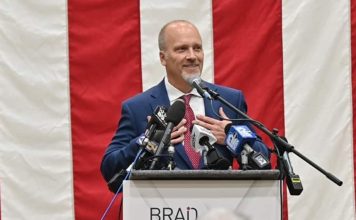Unions see a clear path through the legislature to boost membership after several legal challenges saw workers leave in droves.
This, according to a new report released Wednesday that grades public sector labor laws across the nation. The data was compiled by the Commonwealth Foundation, a policy group that focuses on fiscal conservancy.
David Osborne, senior fellow for labor policy at the foundation, said during a media briefing that government privatization, changing demographics and a 2018 Supreme Court decision, Janus v. AFSCME Council 31, have caused membership rates across the nation’s four largest public sector unions to fall more than 320,000 over the last five years.
The decline represents $106.8 million in annual dues and fees, according to the report.
“The overarching theme is that the unions have really responded to the membership losses since JANUS to drive up union membership,” Osborne said.
In the JANUS decision, courts held that unions could no longer collect “fair share” dues from non-members who benefit from collective bargaining agreements. Follow-up litigation has challenged the cumbersome process many former members had to overcome to leave the union and recoup dues improperly withheld.
In the report, states known as union “strongholds” scored lower than others that have enacted collective bargaining reforms.
Illinois, Michigan and Maryland stood out for unprecedented reforms that, in some cases, have constitutionally rooted union protections and tipped the scales in favor of executives, according to the report.
Illinois, for example, enshrined collective bargaining rights into the state constitution, which extended unionizing rights to every workplace, including those once considered inappropriate. Osborne said the “experiment could have really disastrous implications,” such as raising taxes to fund “outrageous” union demands.
He pointed to recent collective bargaining negotiations with Chicago Public Schools, during which leadership asked for abortion care access, affordable housing, homeless shelters in schools and all-electric bus fleets.
“The legislature wouldn’t have any opportunity to overrule that behavior,” Osborne said. “It would take a constitutional amendment to correct that balance.”
California, Pennsylvania and Vermont have considered similar amendments – the latter two more seriously, he added.
In Michigan, which slipped from a “B” to a “D” over the last two years, lawmakers repealed the“paycheck protection” law – which prevents public payroll systems from deducting union dues and political contributions – as was the state’s Right to Work provision. The state also gives unions access to employees’ personal information.
Some 13 other states give unions the same data collection power. In Hawaii, unions even store Social Security numbers to verify workers’ identities. The report says the practice leaves information vulnerable to ransomware attacks – like one that happened earlier this year in California.
Maryland, Delaware and California also offer tax incentives for union membership as way to boost recruits. While Delaware’s labor laws earned a “D” in the report, Maryland and Delaware – along with Illinois, Oregon and Washington – earned an “F” grading.
The nation’s four largest public sector unions – the American Federation of Teachers; the American Federation of State, County and Municipal Employees; the National Education Association; and the Service Employees International Union – collectively represent 6.6 million workers.
AFSCME, according to records submitted to the U.S. Department of Labor, has lost 7.5% of its members since 2017, outpacing the other three unions between 2.8 percentage points and 4 percentage points.
“I do think JANUS is playing a big role in this,” said Andrew Holman, a policy analyst at the Commonwealth Foundation. “And I think after the decision, people are becoming more and more aware of what their dollars are being put toward and are saying, ‘I don’t want to be a part of this.’”
Osborne said 60% of membership fees, albeit funneled through outside organizations, support political causes. Even though members may be aligned ideologically, many feel “uncomfortable” with resolutions that take positions on issues like the war in Gaza or abortion rights.
Unions have refuted this claim in the past, such as the Pennsylvania State Education Association, which is under review by several state agencies for alleged funneling of union dues to support Gov. Josh Shapiro’s 2022 campaign. The state’s labor laws scored a “D” in the report.
“None of the issues seem to relate to what it is to be a teacher, for instance, so many of the members come home feeling like my union has really taken a stance on these political matters that have divided the workplace rather than united it,” Osborne said.
Of the highest-ranking states, Florida “sets a new gold standard,” according to the foundation. The most impactful reform, Osborne said, requires unions to run for “recertification” once membership drops below 60%. This means workers can decide whether to keep representation.
“We’ve seen a bunch of unions fail to file for reelection because they know they’ll lose,” Osborne said. “This ends up removing a union that never had majority support to begin with.”
Wisconsin and Iowa also require recertification. Unions in other states – like Pennsylvania, Illinois, New York and California – have never run for “reelection” since organizing in the 1970s.
Christen Smith
Go to Source
Reposted with permission











![WATCH: Elon Musk Town Hall Rally in Green Bay [FULL Video]](https://www.wisconsinrightnow.com/wp-content/uploads/2022/04/Elon_Musk_3018710552-356x220.jpg)



![The Wisconsin DOJ’s ‘Unlawful’ Lawman [WRN Voices] josh kaul](https://www.wisconsinrightnow.com/wp-content/uploads/2025/03/MixCollage-29-Mar-2025-08-48-PM-2468-356x220.jpg)







![Phil Gramm’s Letter to Wall Street Journal [Up Against the Wall]](https://www.wisconsinrightnow.com/wp-content/uploads/2025/03/gramm-356x220.png)










